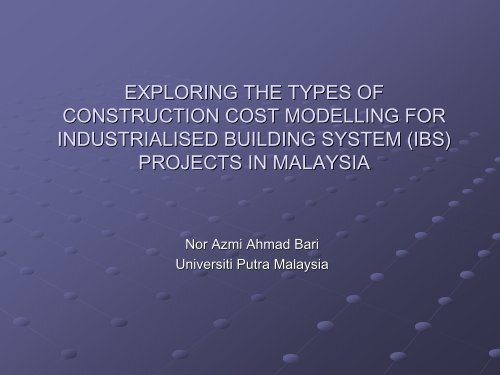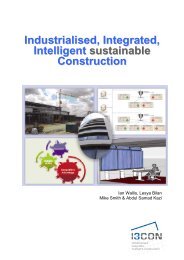exploring the types of construction cost modelling for - i3Con
exploring the types of construction cost modelling for - i3Con
exploring the types of construction cost modelling for - i3Con
Create successful ePaper yourself
Turn your PDF publications into a flip-book with our unique Google optimized e-Paper software.
EXPLORING THE TYPES OF<br />
CONSTRUCTION COST MODELLING FOR<br />
INDUSTRIALISED BUILDING SYSTEM (IBS)<br />
PROJECTS IN MALAYSIA<br />
Nor Azmi Ahmad Bari<br />
Universiti Putra Malaysia
Introduction:<br />
Construction <strong>cost</strong> is an important element that should be monitored<br />
at different phases <strong>of</strong> <strong>the</strong> building <strong>construction</strong> process.<br />
Construction <strong>cost</strong> is a factual process designed to give a reliable<br />
le<br />
estimation or prediction <strong>of</strong> its financial <strong>cost</strong>.<br />
Cost estimating is<br />
‘a a fundamental activity which combine <strong>of</strong> a mechanical process and<br />
subjective expertise undertaken to assess and predict <strong>the</strong> total <strong>cost</strong><br />
executing <strong>of</strong> <strong>construction</strong> works. It consists <strong>of</strong> application <strong>of</strong> appropriate<br />
methods <strong>of</strong> estimating to <strong>the</strong> measures finished quantities <strong>of</strong> appropriate<br />
building’.<br />
The purpose <strong>of</strong> <strong>construction</strong> <strong>cost</strong> estimation is to provide in<strong>for</strong>mation<br />
<strong>for</strong> <strong>construction</strong> decisions including areas in <strong>the</strong> procurement and<br />
pricing <strong>of</strong> <strong>construction</strong>, establishing contractual amount <strong>of</strong> payment,<br />
and controlling actual quantities.
Introduction<br />
As <strong>the</strong> <strong>construction</strong> industry is encouraged to adopt innovation in its<br />
trade, it came to <strong>the</strong> industry players’ <strong>for</strong>e to review <strong>the</strong> prevalent<br />
method <strong>of</strong> <strong>cost</strong> estimation <strong>for</strong> <strong>cost</strong> planning and control <strong>of</strong> IBS<br />
projects.<br />
Drawing from that, and appreciating <strong>the</strong> need to re<strong>for</strong>m <strong>the</strong><br />
<strong>construction</strong> industry’s s practices, it was conceived that reviewing <strong>the</strong><br />
existent <strong>construction</strong> <strong>cost</strong> <strong>modelling</strong> used in <strong>the</strong> preparation <strong>of</strong> <strong>cost</strong><br />
planning and control <strong>for</strong> IBS projects would be most expedient and<br />
vital<br />
Its strength should be <strong>the</strong> ability to adhere and remain relevant to<br />
<strong>the</strong> ever-changing technology and design dynamics being<br />
manifested from a progressive <strong>construction</strong> process.
Definition:<br />
Industrialised Building System (IBS)<br />
Author/Researcher<br />
CIDB, 2003b<br />
Trikha, 1999<br />
Warszawski, 1999<br />
Esa and Nuruddin, 1998<br />
Wardi, 1997<br />
Junid, 1986<br />
Definition<br />
A <strong>construction</strong> system which components are manufactured in a<br />
factory, on or <strong>of</strong>f site, positioned and assembled into structures<br />
with minimal additional site work<br />
A system in which concrete components such as wall, floor slab,<br />
beam, column and staircase are mass produced at site or in factory<br />
are assembled to <strong>for</strong>m <strong>the</strong> structure with minimum in situ<br />
<strong>construction</strong>.<br />
A set <strong>of</strong> interconnected elements that joint toge<strong>the</strong>r to enable <strong>the</strong><br />
designated per<strong>for</strong>mance <strong>of</strong> a building.<br />
IBS is a continuum beginning from utilizing craftsmen <strong>for</strong> every<br />
aspect <strong>of</strong> <strong>construction</strong> to a system that make use <strong>of</strong> manufacturing<br />
production in order to minimize resources wastage and enhance<br />
value <strong>for</strong> end users.<br />
A system which uses industrialized production techniques ei<strong>the</strong>r in<br />
<strong>the</strong> production techniques ei<strong>the</strong>r in <strong>the</strong> production <strong>of</strong> components<br />
or assembly <strong>of</strong> <strong>the</strong> building or both.<br />
IBS is a process by which components <strong>of</strong> a building are conceived,<br />
planned and fabricated, transported and erected at site. The<br />
system includes a balanced combination between s<strong>of</strong>tware and<br />
hardware component. The s<strong>of</strong>tware element include system<br />
design, which is a complex process <strong>of</strong> studying <strong>the</strong> requirement <strong>of</strong><br />
<strong>the</strong> end user, market analysis and <strong>the</strong> development <strong>of</strong> standardized<br />
components.
Definition:<br />
Industrialised Building System (IBS)<br />
CIDB, Malaysia<br />
‘A A <strong>construction</strong> system which components are<br />
manufactured in a factory, on or <strong>of</strong>f site,<br />
positioned and assembled into structures with<br />
minimal additional site work’
Definition:<br />
Industrialised Building System (IBS)<br />
Classification <strong>of</strong> <strong>types</strong> <strong>of</strong> IBS according to CIDB;<br />
Type 1: Precast Concrete Framing, Panel and Box<br />
Systems<br />
Type 2: Steel Formwork Systems<br />
Type 3: Steel Framing Systems<br />
Type 4: Prefabricated Timber Framing Systems<br />
Type 5: Blockwork Systems
Definition:<br />
Cost Modelling<br />
Ferry et al. (1997)<br />
“The symbolic representation a system, expressing <strong>the</strong> content <strong>of</strong> that<br />
system in terms <strong>of</strong> <strong>the</strong> factors which influence its <strong>cost</strong>s”.<br />
Seeley (1996)<br />
“a a procedure developed to reflect, by means <strong>of</strong> derived processes,<br />
adequately acceptable output <strong>for</strong> an established series <strong>of</strong> input<br />
data”.<br />
Ashworth (1999)<br />
“techniques used <strong>for</strong> <strong>for</strong>ecasting <strong>the</strong> estimated <strong>cost</strong> <strong>of</strong> a proposed<br />
<strong>construction</strong> project”.<br />
There<strong>for</strong>e, all methods, techniques or procedures used by quantity<br />
surveyors <strong>for</strong> <strong>cost</strong> estimation or <strong>cost</strong> <strong>for</strong>ecast may be termed as <strong>cost</strong><br />
models.
Type <strong>of</strong> Construction Cost Modelling<br />
Cost estimation models can be classified into three main<br />
generations:<br />
i. Traditional model<br />
Conference,<br />
Financial method,<br />
Functional unit,<br />
Superficial,<br />
Superficial-perimeter,<br />
perimeter,<br />
Cube,<br />
Storey enclosure,<br />
Approximate quantity,<br />
Bill <strong>of</strong> quantities.
Type <strong>of</strong> Construction Cost Modelling<br />
ii.<br />
iii.<br />
Non-traditional model<br />
Statistical / Econometric model (Regression analysis and Causal model),<br />
Risk / Simulation model (Monte Carlo simulation and Value<br />
management),<br />
Knowledge-based model,<br />
Resource-based model,<br />
Life cycle model.<br />
New wave model<br />
Artificial intelligent system (Neural network and Fuzzy logic),<br />
O<strong>the</strong>r models (Environmentally and Sustainable development).
Type <strong>of</strong> Construction Cost Modelling<br />
Choices <strong>of</strong> estimation models will be influenced by many factors:<br />
In<strong>for</strong>mation and time available<br />
Experience <strong>of</strong> <strong>the</strong> estimator/quantity surveyor<br />
The amount and <strong>for</strong>m <strong>of</strong> <strong>cost</strong> data<br />
Purpose <strong>of</strong> <strong>the</strong> estimates<br />
Techniques to be adopted
Objective <strong>of</strong> <strong>the</strong> Study<br />
To identify <strong>the</strong> most widespread or preferred<br />
incidence-in<br />
in-use (IIU) <strong>of</strong> <strong>cost</strong> estimation<br />
model being employed by <strong>the</strong> Malaysian<br />
QS <strong>for</strong> projects using IBS.
Methodology<br />
Adopted a self-administered, 6 pages postal<br />
questionnaire<br />
The questionnaires were sent to all QS firms<br />
registered with Board <strong>of</strong> Quantity Surveyors,<br />
Malaysia (N=278)<br />
15% firms responded and than computed and<br />
analysed descriptively using SPSS.
Analyses <strong>of</strong> Data<br />
Demographic pr<strong>of</strong>ile <strong>of</strong> <strong>the</strong> respondents<br />
Majority (94.9%) have between 10-30 years <strong>of</strong> working experience<br />
in <strong>construction</strong> industry.<br />
Majority (61.5%) have between 1-101<br />
10 years <strong>of</strong> working experience in<br />
<strong>the</strong> organisation<br />
Majority (64%) posses a high level <strong>of</strong> academic qualification; ie.<br />
Degree holders.<br />
Majority covers a spectrum <strong>of</strong> high ranking personnel in which half<br />
(52.7%) <strong>of</strong> <strong>the</strong> respondents belong to <strong>the</strong> Top Management level,<br />
such as director, principal, managing here director, etc.<br />
There<strong>for</strong>e, <strong>the</strong> in<strong>for</strong>mation provided by <strong>the</strong> respondents can be<br />
considered as highly reliable and authoritative.
Currently-used used Cost Estimation Model<br />
Table 1: Incidence-in-use (IIU) <strong>of</strong> Traditional Types <strong>of</strong> Cost Estimation Model<br />
Modelling Average Point Average Incidence-in-use<br />
Rank<br />
(IIU), N= 41<br />
Conference 2.2 1% - 33% 8<br />
Financial method 2.9 1% - 33% 6<br />
Functional unit 3.0 34%-66% 5<br />
Superficial 3.9 34%-66% 2<br />
Superficial-perimeter 2.2 1% - 33% 7<br />
Cube 1.8 0% 10<br />
Storey-enclosure 2.1 1% - 33% 9<br />
Approximate quantities 4.0 67%-99% 1<br />
Elemental estimating 3.7 34%-66% 4<br />
Bill <strong>of</strong> quantities 3.9 34%-66% 3
Currently-used used Cost Estimation Model<br />
Table 2: Incidence-in-use (IIU) <strong>of</strong> Newer Non-Traditional Types <strong>of</strong> Cost Estimation Model<br />
Modelling Average Point Average Incidence-inuse<br />
Rank<br />
(IIU), N=41<br />
Regression analysis 1.5 0% 4<br />
Causal model 1.5 0% 5<br />
Monte Carlo<br />
1.3 0% 6<br />
simulation<br />
Value management 2.4 1% - 33% 1<br />
Knowledge-based<br />
1.3 0% 7<br />
model<br />
Resource-based model 2.0 1% - 33% 2<br />
Life-cycle model 1.7 0% 3
Currently-used used Cost Estimation Model<br />
Table 3: Incidence-in-use (IIU) <strong>of</strong> New Wave Types <strong>of</strong> Cost Estimation Model<br />
Modelling Average Point Average Incidencein-use<br />
Rank<br />
(IIU), N=41<br />
Neural network 1.2 0% 2<br />
Fuzzy logic 1.2 0% 3<br />
Environmentally &<br />
Sustainable development<br />
1.6 0% 1
Findings<br />
Traditional <strong>types</strong> <strong>of</strong> <strong>cost</strong> model were, in general, still <strong>the</strong> most widely<br />
used.<br />
The newer, only <strong>the</strong> value management, resource based model, and<br />
life-cycle <strong>cost</strong> model <strong>cost</strong>s being in general use.<br />
Brandon (1982), had proposed to <strong>the</strong> <strong>construction</strong> industry to shift<br />
towards a more innovative and dynamic <strong>cost</strong> model<br />
From <strong>the</strong> study, it can be surmised that <strong>the</strong> continued and<br />
overwhelming use <strong>of</strong> <strong>the</strong> traditional <strong>types</strong> <strong>of</strong> <strong>cost</strong> model at <strong>the</strong><br />
expense <strong>of</strong> <strong>the</strong> newer non-traditional <strong>types</strong> have somewhat<br />
stigmatised Brandon’s s call <strong>for</strong> paradigm change.
Findings<br />
Reasons why <strong>the</strong> traditional <strong>cost</strong> estimation <strong>modelling</strong>s is still being<br />
widely used :<br />
1. lack <strong>of</strong> familiarity with <strong>the</strong> newer techniques;<br />
2. time constrain, plus lack <strong>of</strong> in<strong>for</strong>mation and knowledge;<br />
3. doubts whe<strong>the</strong>r <strong>the</strong>se techniques are replicable to o<strong>the</strong>r projects;<br />
4. most <strong>construction</strong> projects are not large enough to warrant <strong>the</strong> use u<br />
<strong>of</strong> <strong>the</strong>se techniques or research into <strong>the</strong>m;<br />
5. <strong>the</strong>y require <strong>the</strong> availability <strong>of</strong> sound data to ensure confidence;<br />
e;<br />
6. <strong>the</strong> degree <strong>of</strong> sophistication is seen as too superfluous <strong>for</strong> an<br />
average project;<br />
7. <strong>the</strong> vast majority <strong>of</strong> risks are contractual or <strong>construction</strong>-related, related, and<br />
are fairly subjective such that <strong>the</strong>y can be dealt with better on <strong>the</strong><br />
basis <strong>of</strong> personal experience or from previous contracts undertaken<br />
en<br />
by <strong>the</strong> company.
Conclusion<br />
The traditional type <strong>of</strong> <strong>cost</strong> estimation models continue to<br />
be in widespread use irrespective <strong>of</strong> organisational type<br />
and size.<br />
This phenomenon is comparable to findings from o<strong>the</strong>r<br />
similar researches conducted in countries like <strong>the</strong> UK,<br />
Hong Kong, Australia and Nigeria.
Conclusion<br />
An appraisal or review <strong>of</strong> <strong>the</strong> <strong>cost</strong> estimation practices in<br />
<strong>construction</strong> projects is essential particularly <strong>of</strong> those<br />
using IBS.<br />
This is vital in order <strong>for</strong> IBS to be well placed, and<br />
accordingly evolve with <strong>the</strong> various innovations that<br />
transpire within <strong>construction</strong> industry.<br />
If need be, <strong>the</strong> appraisal must also be re-strategised<br />
to<br />
take advantage <strong>of</strong> <strong>the</strong> various benefits presented by <strong>the</strong><br />
newer non-traditional and new wave <strong>cost</strong> estimation<br />
models in <strong>cost</strong> planning and control practices.






